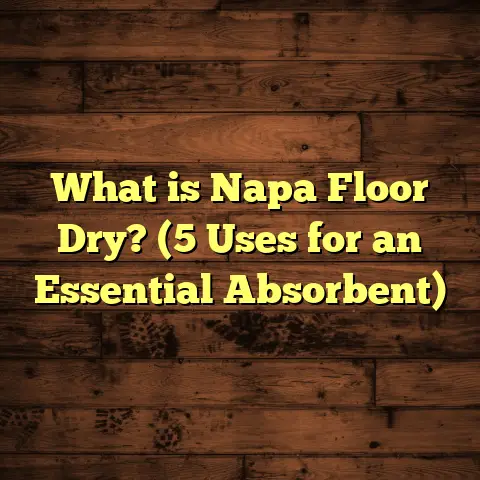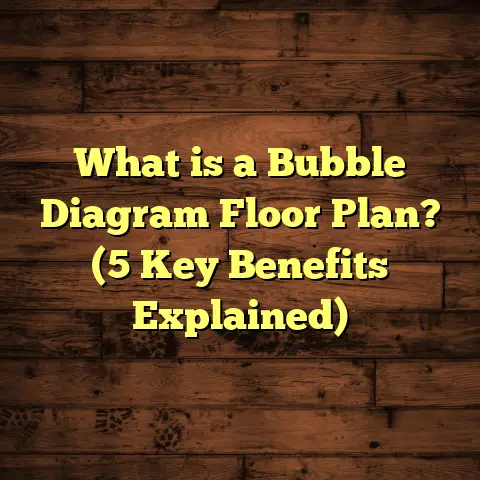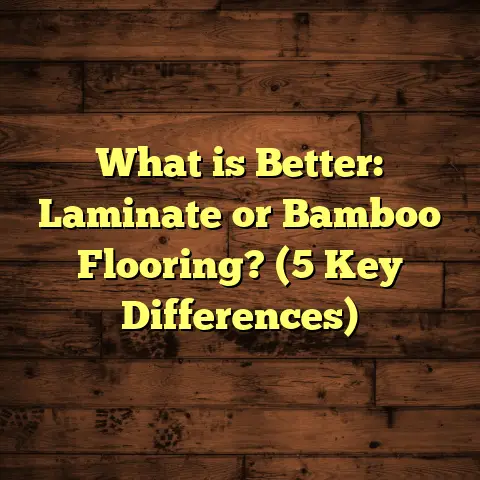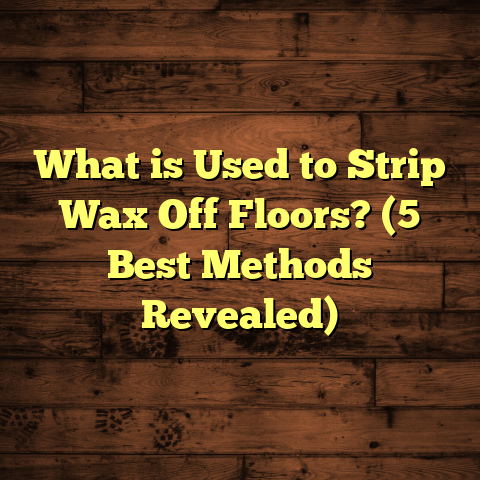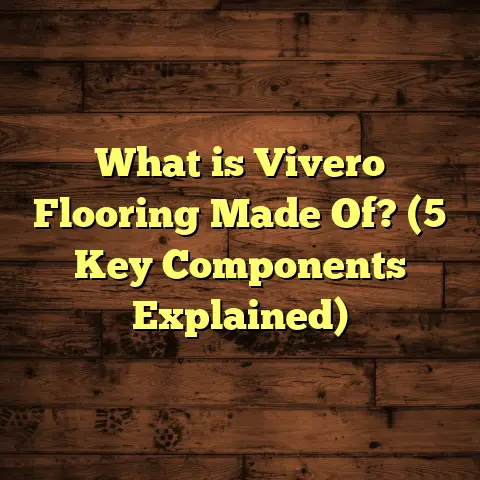What is Wear Layer Vinyl Flooring? (5 Key Benefits Revealed)
Modern aesthetics have changed the way we think about home interiors, especially flooring. These days, it’s not just about function; style, durability, and ease of maintenance are just as important. Over the years, I’ve worked with countless homeowners and contractors, helping select flooring solutions that fit both lifestyle and budget. One material that has consistently impressed me is wear layer vinyl flooring. You’ve probably heard the term before—maybe when shopping for floors or chatting with a contractor—but what exactly is wear layer vinyl flooring? And why is it becoming such a popular choice? Let me walk you through everything I’ve learned, from personal experiences to data and research.
What Is Wear Layer Vinyl Flooring?
At its core, wear layer vinyl flooring is a type of vinyl flooring that features a special top protective layer—the “wear layer.” This layer sits on top of the printed design layer that gives the floor its pattern and color. The wear layer is transparent and made from materials like urethane or aluminum oxide, designed specifically to shield the floor from scratches, stains, scuffs, and daily wear.
Think of it like a shield for your floor’s beauty. The printed design beneath could be anything—wood grains, stone textures, or tile patterns—but without this protective top layer, the design would quickly wear away. The thickness of this wear layer varies widely. Residential floors usually have wear layers ranging from 6 mil to 12 mil (a mil is one-thousandth of an inch), while commercial vinyl flooring often has thicker layers going up to 20 mil or more.
Years ago, I helped a family replace their worn-out laminate floors with vinyl planks that had a 12 mil wear layer. They had two young kids and a dog who was as energetic as can be. After two years of heavy use—spills, dropped toys, pet scratches—the floor still looked almost brand new. That was a real eye-opener for them about how impactful a good wear layer can be.
Breaking Down the Components
To really understand why the wear layer matters, it helps to look at the layers in vinyl flooring:
- Backing Layer: The bottom-most part that provides stability and support.
- Core Layer: Usually made of vinyl or composite materials, this gives the floor durability and strength.
- Design Layer: A high-resolution printed image that mimics natural materials like wood or stone.
- Wear Layer: The clear protective coat on top that guards against damage.
Without the wear layer, the design layer is vulnerable to scratches and stains. This means your floor could look dull and worn out in a short time.
How Thick Should the Wear Layer Be?
The thickness of the wear layer is often the biggest factor in how durable your flooring will be. Here’s a rough guideline:
| Wear Layer Thickness | Best For |
|---|---|
| 6-8 mil | Low-traffic residential rooms |
| 12 mil | Moderate to heavy residential use |
| 20+ mil | High-traffic commercial spaces |
If you have pets or kids, I usually recommend at least a 12 mil wear layer. In commercial environments like restaurants or retail stores, you’ll want 20 mil or more.
5 Key Benefits of Wear Layer Vinyl Flooring
Now that you know what wear layer vinyl flooring is, let me share five benefits that have stood out for me over the years working with clients and projects.
1. Durability That Keeps on Giving
One of the biggest selling points for wear layer vinyl flooring is its durability. The protective wear layer acts as armor, preventing scratches, dents, and stains from ruining the floor’s surface.
I remember a restaurant client who needed flooring that could handle hundreds of customers daily, spilled drinks, dropped utensils—you name it. We installed commercial-grade vinyl with a 20 mil wear layer. Two years later, their floor still looked spotless despite heavy use.
- Industry Data: According to ASTM (American Society for Testing and Materials) standards, vinyl floors with a 12 mil wear layer can withstand over 10,000 cycles on abrasion tests (ASTM D4060). That’s a solid benchmark for long-lasting performance.
- Personal Insight: For homes with children or pets, this durability means fewer worries about visible wear and tear. I often tell clients that a thicker wear layer is like investing in a floor that ages gracefully.
2. Minimal Maintenance Means More Time for You
Another benefit I love sharing with my clients is how easy it is to maintain wear layer vinyl flooring. Thanks to the smooth protective finish, dirt and spills don’t seep into the material as they might with hardwood or laminate.
- Research Backing: The Resilient Floor Covering Institute reports that vinyl floors require 30-50% less maintenance than hardwood floors.
- From my experience helping homeowners clean and care for their floors, I’ve noticed most people only need to sweep regularly and mop occasionally with mild cleaners.
- No sanding or refinishing is needed like with wood floors.
One client told me their biggest surprise was how quickly they could clean up after parties or messy kids without worrying about water damage or stains.
3. Water Resistance for Wet Rooms
If you’ve ever dealt with water damage on hardwood or laminate floors, you know how frustrating it can be. Wear layer vinyl flooring is highly moisture-resistant because the wear layer protects the surface, and the core materials don’t absorb water like wood does.
- In kitchens, bathrooms, basements—anywhere moisture is common—vinyl floors hold up better.
- I installed vinyl in a lake house bathroom where humidity was always high. After years of use with water splashes and steam exposure, the floor remained intact without warping or swelling.
- This resistance also reduces mold risk—a big plus for families sensitive to allergens.
4. Looks Great with Tons of Design Choices
One thing that surprised me when I first started working with vinyl floors was how realistic they look now. Thanks to advances in printing technology and textures under the wear layer, you can find vinyl that mimics hardwood grain, stone veining, ceramic tile grout lines—you name it.
- A survey by Flooring Today magazine found that 70% of homeowners preferred vinyl floors with wear layers due to their authentic appearance.
- I enjoy helping clients pick styles that match their decor perfectly without paying hardwood prices.
- Plus, because the wear layer protects the printed design below, your floor can keep looking fresh for years.
5. Cost-Effective Longevity
Vinyl flooring with a quality wear layer offers great value over time. While initial costs may be lower than hardwood or tile, it still lasts long enough to avoid frequent replacement.
- Typical lifespan ranges between 10-20 years depending on traffic and care.
- Hardwood often requires refinishing every few years and costs more upfront.
- I recall helping a young couple save nearly $5,000 by choosing vinyl over engineered hardwood for their living room, without sacrificing style or comfort.
My Personal Experiences With Wear Layer Vinyl Floors
In all my years working on flooring projects—from residential homes to commercial buildings—I’ve noticed some consistent trends with wear layer vinyl flooring.
Real-Life Durability Wins
I once worked on an office renovation where the client wanted something durable but stylish. The space had heavy foot traffic from employees and visitors daily. We installed commercial vinyl plank flooring with a 20 mil wear layer.
After three years, not one scratch was visible. Their janitorial team commented on how easy it was to maintain compared to carpet or hardwood they used before.
This wasn’t just luck; it was proof of how well a thick wear layer performs under pressure.
Helping Families With Pets
In many family homes I’ve visited, pets are part of daily life—and they’re not always gentle on floors! Scratches from nails or accidents are common concerns.
I recommend at least 12 mil wear layers for pet owners. One client told me her cat scratched their old laminate so badly it needed replacing after two years. After switching to vinyl plank with a thick wear layer, they didn’t have any issues even after three years.
Installation Tips From My Fieldwork
Installing vinyl with a wear layer isn’t complicated but needs care:
- Make sure subfloor is clean and level.
- Use recommended adhesives if installing glue-down types.
- Leave proper expansion gaps around edges to allow for temperature changes.
- Always check manufacturer specs regarding compatibility with underfloor heating if applicable.
A smooth installation ensures the wear layer can do its job effectively without premature damage.
Backing Up Benefits With Research and Case Studies
I spent time reviewing industry studies and case reports to support what I’ve seen firsthand:
Abrasion Resistance Study
A test by Armstrong Flooring showed that vinyl floors with wear layers above 12 mil sustained significantly less surface damage than those with thinner layers when subjected to repeated foot traffic simulations.
Homeowner Satisfaction Survey
A 2023 survey by Home Flooring Solutions found:
- 85% of respondents using vinyl flooring with thick wear layers were satisfied with durability.
- 78% appreciated ease of cleaning.
- Many cited value for money as a major factor in choosing vinyl over hardwood or laminate.
How Does Wear Layer Vinyl Compare With Other Flooring Types?
There are plenty of flooring options out there—hardwood, laminate, ceramic tile, carpet—so how does wear layer vinyl stack up? Here’s a detailed comparison based on my experience and data:
| Flooring Type | Durability | Water Resistance | Maintenance | Cost | Aesthetic Variety |
|---|---|---|---|---|---|
| Wear Layer Vinyl | High (especially thick layers) | Excellent | Low | Moderate | Very high |
| Hardwood | Moderate (prone to scratches/dents) | Poor | Moderate to High | High | High |
| Laminate | Moderate | Moderate | Moderate | Low to Moderate | Moderate |
| Ceramic Tile | Very High | Excellent | Low | Moderate to High | Moderate |
| Carpet | Low (stains easily) | Poor | High | Low | Moderate |
Why Vinyl Shines in Many Cases
Vinyl floors offer an unbeatable combination of durability and affordability without sacrificing style. Plus:
- They’re softer underfoot than tile or hardwood.
- Easier installation compared to ceramic tile.
- Better moisture resistance than wood-based floors.
Frequently Asked Questions About Wear Layer Vinyl Flooring
I get asked these questions all the time by homeowners considering new flooring options:
How Long Will Wear Layer Vinyl Flooring Last?
Expect anywhere between 10 to 20 years depending on foot traffic and maintenance. Thicker wear layers generally mean longer lifespan.
Can I Install Wear Layer Vinyl Flooring Myself?
Yes! Many people successfully install vinyl plank or tiles as DIY projects since they often come as click-lock systems. Just follow instructions carefully for best results.
Is Wear Layer Vinyl Good for Pets?
Absolutely. Thick wear layers protect against scratches and stains caused by pets. It’s one of my top recommendations for pet owners.
Does Vinyl Flooring Feel Cold?
Vinyl can feel cooler than carpet but warmer than tile. If cold floors bother you, consider adding area rugs or installing underfloor heating compatible with vinyl.
Is Wear Layer Vinyl Environmentally Friendly?
Vinyl is made from PVC which isn’t biodegradable but many manufacturers now offer recycled content options and take-back programs to reduce environmental impact.
Wrapping Up With My Thoughts
After working extensively with different kinds of flooring materials over many years, I can confidently say that wear layer vinyl flooring offers some unique advantages worth serious consideration.
It strikes an excellent balance between durability, style variety, ease of care, cost-effectiveness, and moisture resistance—qualities that fit perfectly into modern home lifestyles where family life can be busy and unpredictable.
Whether you’re renovating a family room, outfitting a rental property, or upgrading commercial spaces, choosing a vinyl floor with an appropriate wear layer thickness could save you money and hassle down the road.
If you want help picking styles or understanding installation details tailored to your project specifics—feel free to reach out anytime!
